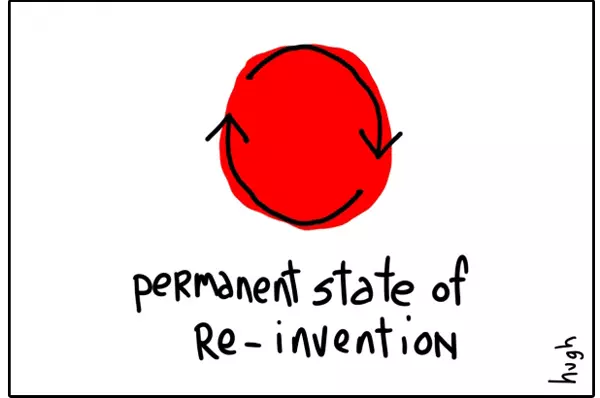August 2011

Early in 2010, I became familiar with cartoonist and author Hugh MacLeod through his humorous yet provocative book titled Ignore Everybody and 39 Other Keys to Creativity. I thoroughly enjoyed this book and its many insights, even writing an e-newsletter about key #7, "Everyone is born creative; everyone is given a box of crayons in kindergarten." Searching for more information on Hugh, I came across his blog and web site, www.gapingvoid.com, offering me the opportunity to sign up for an e-newsletter of daily cartoons. I always enjoy Hugh's offbeat humor, which comes through in both his cartoons and the accompanying descriptions. This one, from July 28, 2011, really spoke to me:
Permanent State of Re-Invention
"I first drew this in 2004. A wee doodle that I thought very little about at the time.
Yet over time, the simplicity of the message seems to have resonated with a lot of people.
Any fool can be a burnout or a calcified dinosaur. Reinvention is much harder. And to keep doing it, again and again? MUCH, MUCH harder.
But that's what makes it so worth doing..."
– Hugh MacLeod
The reason it spoke to me? With the firm's anniversary just days away, the cartoon caused me to reflect on our 22 years in business and how many times I have had to re-invent both the firm and myself. After initially hanging out my shingle, most of my work the first 3 years was "General Management Consulting," often troubleshooting various accounting or management issues.
Re-Invention Brought by Technology
Near the end of that period, personal computer software was becoming more robust and powerful, and requested services frequently included questions such as "How can we use technology to address this problem?" One of the first projects during this "re-invention" was developing a product cost sheet system for a fashion apparel designer and merchandiser. While this client's parent company had its own product cost sheet application, that system was not geared to the then-revolutionary (1992) idea of completely outsourcing garment production. Thus began our "Application Development" services for a standalone application.
After that application was successfully deployed, the question then became, "Okay, we track production on the AS/400, have cost sheets on a PC server, and do our accounting on the AS/400 – how can we get all these systems to work together?" Going back into design and development mode, out came our first "System Integration" application.
Re-Invention as New Hires Expand Our Capabilities
As word began to spread of these successes, I was becoming more and more busy, so I hired my first part-time consultant (in 1994) and my first full-time consultant (in 1996) to help. With these personnel additions came some valuable new skills in system selection and system implementation – just in time for Year 2000 and another re-invention. The rush to review systems for Y2K issues was on, and – because many systems were custom-written (and poorly, at that) – it was often less expensive to select and implement a new system than to remediate an existing one. Over the next several years, we spent a lot of time on "System Selection" and "System Implementation" projects, primarily on complex applications known as Enterprise Resource Planning (ERP) systems.
Multiple Re-Inventions from Evolving Client Needs
With many companies having just implemented new business systems focusing on transaction processing, clients' questions turned to "what's next to improve?" The answer? Collaboration among employees and business partners, which was either non-existent or poorly developed in even the best ERP systems – and, you guessed it, another re-invention opportunity. Thus, in the early 2000's, we began a series of "Process Improvement" projects, frequently culminating in the client asking us to implement these improvements in "Workflow Automation" software, which we either developed ourselves, or worked with their staff to design and develop.
Other examples of re-invention abound: Around 2006, a client asked us to work on several projects that identified additional sources of revenues for local governments, becoming not only our first large-scale "Data Analysis" projects, but also the first projects requiring us to design and develop internal software and automated processes to handle them. Soon afterwards, we leveraged that success to begin building "Data Warehouses" to help answer more complex and sophisticated questions, such as "How can we reduce our inventory levels, while not affecting service quality?"
Throughout the years, my staff or I had occasionally served as a client's "Interim Controller" or "Interim Finance Director" for short periods while they filled a vacant position. In 2007, I obtained a new client who had back-to-back weak finance directors, resulting in poor systems implementations and low credibility with the Board of Directors. Working with their executive director, managers, and staff, I guided them to reconfigure their information systems and restore confidence and integrity in their financial statements.
In 2009, we began using then-new techniques such as XML and Web Services to develop "Composite Applications" to improve the productivity of call center representatives. That same year, we also began a new service line, "Managing System Implementations," to address a critical need – project management. Project management is absolutely essential to ensure a smooth system implementation, yet the software vendor typically relies on the client to perform this, and the client assumes the vendor will fill this role, resulting in scant or ineffective project management, wasted time and money, and high frustration.
Recently, as a result of our earlier work with a large client and having developed strong data analysis skills over the years, we were able to say "yes" when this client asked if we could help them develop a business case for a data warehouse and executive dashboard to fulfill a major part of their strategic plan. After that initial "Data Warehouse Business Requirements" project was presented to the Board, the overall project was approved. We were then asked to lead the design and development of this "Business Intelligence" project consisting of a data warehouse and an executive dashboard.
Change is Unchanging – Re-Invention as Permanent Business Strategy
Looking back over the years, I see just how many times I needed to re-invent both myself and the firm to adapt to changing client needs and market direction. I believe this re-invention is actually a requirement for any firm using technology to help solve business problems. Both the problems themselves and the available technology can, and usually do, change greatly over just a few years.
During a recent monthly meeting with two of my key advisers, we shared a conversation reflecting all this:
- Advisers – So, what's the strategic plan of the firm?
- Todd – To successfully adapt to changing conditions in technology, the local market, and the general economy.
- Advisers – (surprised) Really?
- Todd – Yes. In fact, I view our core competency as our ability to re-invent ourselves, both individually and as a firm.
- Advisers – (puzzled) Hmmmm....
Even though I related most of these examples to them, I am not sure they fully believed me. Yet, it's the truth.
Thus, Hugh's cartoon was both timely and accurate – it distilled the staying power of Todd Herman Associates in a clever "wee doodle" and a few accompanying words.
I have also considered how this drawing and its theme are relevant to every business and every working person, not just to me, my firm, and my staff. Downsizing, right sizing, restructuring, process automation, replacing labor with capital, outsourcing, offshoring, and more – all increasingly common as businesses adapt to a global economy, demanding customers, and a slow economic recovery in the United States, and all requiring re-invention by both companies and individuals.
How about you? How many times have you had to re-invent yourself, significantly changing responsibilities, upgrading skills, or even moving to a completely different industry? If you have not yet undertaken any of these, do you anticipate needing to do so before you retire? If "yes," welcome to the club. If "no," you might want to consider plans to do so – or face becoming highly vulnerable to being left behind during this time of unprecedented volatility.
![]()
Todd L. Herman







